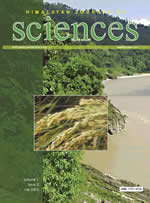Evaluation of cultivars and land races of <i>Oryza sativa</i> for restoring and maintaining wild abortive cytoplasm
DOI:
https://doi.org/10.3126/hjs.v1i2.203Keywords:
CMS line, maintainer, restorer, riceAbstract
Identification of restorers and maintainers from cultivars and landraces through test crossing and their use in further breeding programme are the initial steps in three-line heterosis breeding. Two experiments, one in the greenhouse for F1 hybrid seeds production and another in the field for parental screening, were conducted during the 1999 rice growing season at the Institute of Agriculture and Animal Science (IAAS, TU), Rampur, Nepal. Three cytoplasmic male sterile (CMS) lines, eight improved cultivars and six landraces of rice were studied for their fertility restoring and sterility maintaining abilities. Pollen sterility was studied based on their stainability with potassium iodide iodine (I-KI) solution. On the basis of their interaction with I-KI, pollens were categorized as unstained withered sterile (UWS), unstained spherical sterile (USS), stained round sterile (SRS) and stained round fertile (SRF). For each hybrid, the percentage of spikelet fertility was estimated. The test lines were categorized as restorers, partial restorers, maintainers, and partial maintainers on the basis of pollen sterility and spikelet fertility. The male sterile lines had mostly UWS and USS types of pollen, whereas the restorer lines had more SRS and SRF types. There was no strong evidence for a relationship between pollen fertility and spikelet fertility. Five restorers, three partial restorers, two partial maintainers and four maintainers were identified. These restorers can be used to develop the hybrid seed while maintainers to maintain and/or to develop new CMS lines, because these are locally adapted cultivars. Pedigree analysis revealed that, for some of these test lines, TN-1 and CR94-13 might be the donors of maintainer and restorer gene(s), respectively. Key words: CMS line, maintainer, restorer, rice Himalayan Journal of Sciences 1(2): 87-91, 2003Downloads
Download data is not yet available.
Abstract
792
PDF
796
Downloads
How to Cite
Joshi, B. K., Subedi, L. P., Gurung, S. B., & Sharma, R. C. (2006). Evaluation of cultivars and land races of <i>Oryza sativa</i> for restoring and maintaining wild abortive cytoplasm. Himalayan Journal of Sciences, 1(2), 87–91. https://doi.org/10.3126/hjs.v1i2.203
Issue
Section
Research Papers




